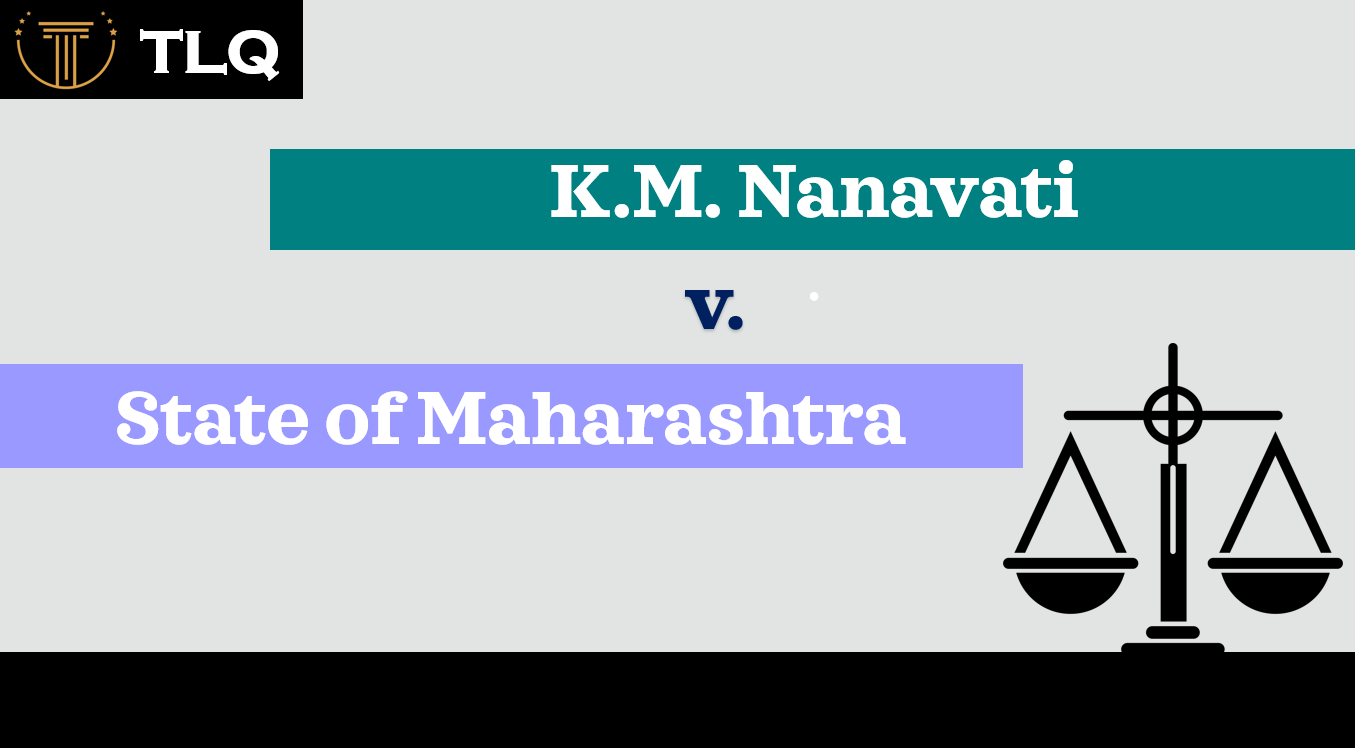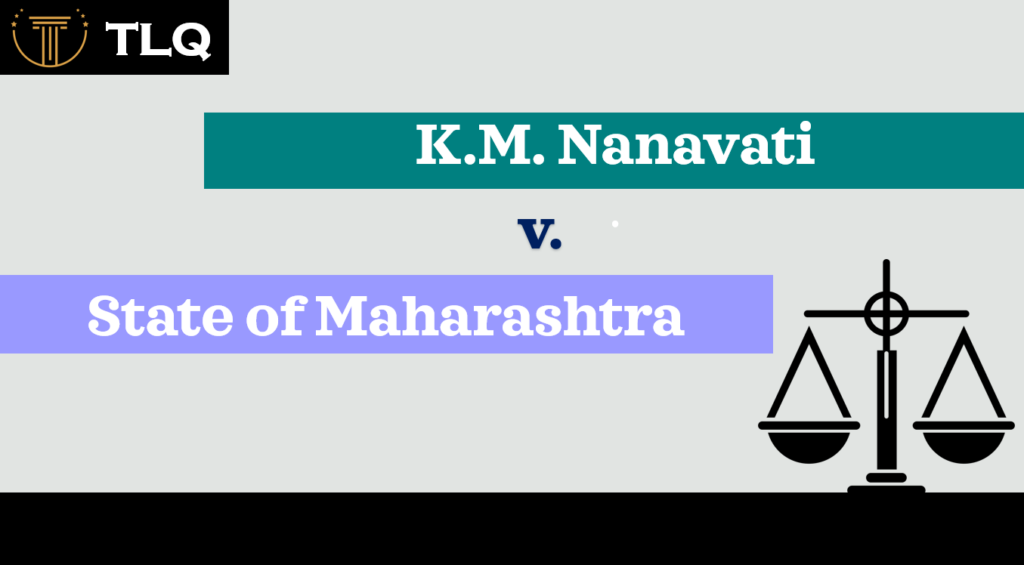Published On: 3rd May, 2024

Authored By: Dhruv Shrivastava
Prestige Institute of Management and Research, Gwalior
Introduction:
The verdict in the K.M. Nanavati case, delivered on November 24, 1961, has withstood the test of time, remaining etched in the collective consciousness of the populace. The circumstances surrounding this case garnered unprecedented media attention, inspiring a plethora of literary works, television series, and cinematic adaptations over the decades.[1]
Nanavati, the accused/appellant, a naval officer, faced trial under Section 302 of the Indian Penal Code for the alleged murder of his wife’s lover[2]. This case is regarded as a landmark judgment, not merely due to its widespread popularity but also because of the significant legal issues it addressed, such as the plea of general exception, the burden of proof, the grave and sudden provocation test, and the High Court’s authority in assessing the competence of a reference made by the Sessions Judge.
The Nanavati case is widely recognized as the catalyst that ultimately led to the abolition of jury trials in India.
Let us delve into the compelling details of this remarkable case.
Factual Background:
- Nanavati held the rank of second-in-command on the Indian naval ship “Mysore.” He was married to Sylvia, and the couple had three children. Due to the nature of his profession, the Nanavati family had resided in various locations before settling in Bombay. It was here that they were introduced to the deceased, Prem Ahuja, through mutual acquaintances.
- Nanavati’s naval duties frequently required him to be away from Bombay, leaving his wife and children behind. In Nanavati’s prolonged absences due to naval duties, an intimate bond formed between his wife Sylvia and Ahuja, transgressing the boundaries of a platonic rapport.
- Upon returning from his ship on April 18, 1959, Nanavati attempted to be affectionate with his wife on multiple occasions, but she remained unresponsive. On April 27, 1959, when his advances were once again rebuffed, Nanavati questioned his wife’s fidelity. She responded with a mere shake of her head, indicating her unfaithfulness. Nanavati deduced that Ahuja was her paramour and decided to confront him.
- Nanavati first drove his children and wife to the cinema, promising to pick them up later. He then proceeded to his ship, where he obtained a revolver and six rounds under false pretenses, placing them in a brown envelope. From there, he drove to Ahuja’s office but did not find him, so he continued to Ahuja’s flat.
- Upon arriving at Ahuja’s flat and confirming his presence from a servant, Nanavati entered Ahuja’s bedroom carrying the brown envelope containing the revolver.
- Inside the bedroom, with the door closed behind him, Nanavati inquired about Ahuja’s intentions concerning his wife and children. Dissatisfied with Ahuja’s response, Nanavati allegedly shot him, resulting in his death. After the fateful incident, Nanavati made haste to the closest law enforcement facility to voluntarily disclose and acknowledge his culpable act.
- Initially, a jury found Nanavati not guilty by a verdict of 8:1. However, the Sessions Judge disagreed with this decision, believing that no reasonable group of individuals could reach such a verdict based on the evidence presented. The matter was referred to a Division Bench, which found the accused/appellant guilty.
Consequently, this appeal was filed before the Hon’ble Supreme Court of India, seeking special leave.
Issues Raised:
After the fateful incident, Nanavati made haste to the closest law enforcement facility to voluntarily disclose and acknowledge his culpable act:
- Under Section 307 of the Criminal Procedure Code (CrPC), the High Court lacks jurisdiction to review the evidence to determine the competence of the reference made by the Sessions Judge.
- Under Section 307(3) of the CrPC, the High Court does not have the power to set aside the jury’s verdict on the grounds of misdirection in the charge.
- There were no misdirections in the charge given to the jury.
- The verdict rendered by the jury was one that a reasonable group of individuals could have reached based on the evidence presented before them.
- The accused/appellant shot the deceased under grave and sudden provocation; therefore, he did not commit murder but culpable homicide not amounting to murder.
Judgment:
- Scope of the High Court’s Power under Section 307 of the CrPC
The Hon’ble Supreme Court explained that in cases where the judge does not agree with the jury’s verdict, they can refer the case to the High Court under subsection (1) of Section 307 of the CrPC. The two necessary conditions for such a referral are: (1) the judge must disagree with the jury’s verdict, and (2) the judge must believe that the jury’s verdict is one that no reasonable individuals could have reached. The order of referral would be deemed competent only if these two conditions are met; otherwise, it would be considered incompetent and rejected by the High Court.
When the order of referral is found to be competent, the High Court is bound to discharge its duties as specified under subsection (3) of Section 307 of the CrPC. Under this subsection, the High Court shall consider the entire evidence, give due weight to the opinions of both the judge and the jury, and thereafter acquit or convict the accused. The contrary interpretation argued by the defendant’s counsel would defeat the purpose of this section.
Reconciling Provisions of Sections 307, 418, and 423 of the CrPC:
The Apex Court held that subsection (2) of Section 423 merely restates the scope of the limited jurisdiction conferred on the High Court under Section 418. The powers conferred upon the High Court under Section 307 of the CrPC are akin to those exercised by it in an appeal. The High Court cannot invoke any powers other than those of an appellate court under Section 423 of the CrPC. This interpretation harmonizes these provisions.
It was established that there is a distinction between the two jurisdictions of the High Court: the disposal of an appeal and the consideration of a case submitted by a Sessions Judge who differs from the jury’s verdict. The Hon’ble Court even stated that broader powers are conferred on the High Court under Section 307 of the CrPC than those conferred under Section 418.
-
Burden of Proof:
In Indian law, the burden of proving the accused’s guilt lies with the prosecution. However, when an accused relies upon any exceptions provided in the Indian Penal Code or any other special exception, Section 105 of the Indian Evidence Act comes into play. The Court shall presume against the accused, and the burden shifts to the accused to rebut this presumption. Until the accused successfully rebuts the presumption, the Court shall overlook any circumstances that would potentially bring the case under the purview of the stated exceptions.
The Court further stated that this presumption and shift in the burden of proof do not absolve the prosecution of its burden to prove the ingredients of the offence with which the accused is charged. This burden never shifts. There is no conflict between the general burden on the prosecution and the special burden on the accused. The failure of the accused to rebut the presumption against them would not relieve the prosecution from proving the ingredients of the offence.
-
Misdirections in the Charge:
The Court agreed with the High Court’s findings regarding the misdirection in the charge made by the Judge. It stated that the question of whether a misdirection vitiated the jury’s verdict must be viewed from the perspective of the potential effect it had on the jury, who are laypeople. The Apex Court further stated that the objective of the charge to the jury by the Judge is to explain and present the facts and circumstances of the case before them. It is the duty of the Judge to clearly explain the points of law, their implications, and put forth all the evidence before the jury, enabling them to arrive at the appropriate decision.
-
Considering the Evidence in the Case:
The Apex Court divided the evidence into three parts: (1) evidence relating to the accused’s conduct before the shooting, (2) evidence relating to the accused’s conduct after the shooting, and (3) evidence relating to the actual shooting in Ahuja’s bedroom.
After examining all the evidence, the Hon’ble Court was of the view that the accused/appellant’s conduct was inconsistent with his defense that the deceased was shot accidentally. In fact, he exhibited the demeanor of an individual who sought vengeance on his wife’s lover in a planned and calculated manner. He obtained the revolver under false pretenses and purposefully entered Ahuja’s bedroom with a loaded weapon. He did not inform anyone that he had shot the deceased accidentally until his trial, despite having numerous opportunities to do so. The injuries found on the deceased’s body were consistent with an intentional shooting.
The Court, therefore, concluded that based on the evidence, no reasonable group of individuals could have arrived at the decision reached by the jury. Thus, the jury’s verdict could not stand.
-
The Test of Severe and Abrupt Provocation:
According to Exception 1 to Section 300 of the Indian Penal Code, a culpable homicide does not constitute murder if the following conditions are met:
- The deceased must have provoked the accused.
- The provocation must have been severe and abrupt in nature.
- The provocation must have caused the accused to temporarily lose self-control.
- The accused must have killed the deceased during this state of temporary loss of self-control.
- The provocation must have resulted in either the death of the person who provoked the accused or the accidental death of another individual.
The Apex Court stated that it is impractical to establish a precise, standardized test. The determination of whether the provocation was severe and abrupt must be made by the Court on a case-by-case basis, considering the respective facts and circumstances. Additionally, the Court elucidated that the criterion for determining “severe and abrupt” provocation is whether a reasonable individual from the same social background as the accused, facing similar circumstances, would be sufficiently provoked to lose self-restraint. The fatal act must be traced directly to the influence of intense emotion and the resultant loss of self-control. It must not occur after the accused has had sufficient time to regain composure, as that would allow room for premeditation and calculation.
After examining the facts of the case, the Court arrived at the conclusion that not only had the accused/appellant regained self-control, but he was also considering the future well-being of his family. He had ample time to cool down after his wife confessed her infidelity. His conduct was evidently deliberate and calculated. Consequently, the Court ruled that the facts of this case did not warrant the application of Exception 1 to Section 300 of the Indian Penal Code.
Decree:
The Hon’ble Supreme Court concurred with the High Court’s decision to convict the accused/appellant under Section 302 of the Indian Penal Code and dismissed the appeal.
Aftermath:
It was the unprecedented media coverage that transformed Nanavati into a household name. He was hailed as a hero, an honorable man who loved his wife and fought for her honor, while Ahuja became the villain, a womanizer who received his just deserts. Nanavati had the support of the people, which is why when the jury found him not guilty by a verdict of 8:1, it sent a wave of joy among his supporters.[3]
Members of the Parsi community organized public demonstrations to voice their support for Nanavati. The Blitz editorials also played a significant role, emerging as an active partner of the defense[4]. However, on the other hand, many newspapers reported the blatant disregard for justice in favor of a man with influential connections.[5]
After the Hon’ble Supreme Court’s verdict, Nanavati appealed for a pardon, which was eventually granted due to the following factors:
(1) Nanavati’s background as a member of the naval forces distinguished him from hardened offenders, as he lacked a criminal history,
(2) He was acquainted with the Nehru-Gandhi family, and Vijayalakshmi Pandit was the Governor of Maharashtra,
(3) When the pardon was eventually granted, Nanavati had already spent three years incarcerated as part of his sentence.
(4) The sister of the deceased had also withdrawn her objection to the pardon.
The Impact on Jury Trials:
The Nanavati case is often cited as the catalyst that led to the end of jury trials. In actuality, it wasn’t the final case to undergo trial by jury, but rather one that gained notable renown. The fate of jury trials had been hanging in the balance even before the Nanavati case came into the picture.
Following independence, there was significant discourse surrounding the elimination of jury trials. A decade later, several states, such as Bihar, Uttar Pradesh, and Madras, took steps towards abolishing the system. In November 1958, prior to the Nanavati trial, the Law Commission itself labeled jury trials as ineffective and advised for their abolition[6].
The 1969 Report of the Law Commission observed that juries were being used only in a few cases and then called for their complete removal. It was finally in 1974, when the entire Code of Criminal Procedure underwent a change, that the jury trial system was abolished.
Conclusion:
This is a landmark judgment that becomes even more relevant in the present times, where media trials have become a common occurrence. This judgment demonstrates that the law of the land will always prevail over popular public opinion and influential connections. Courts have the obligation to uphold the principles of the rule of law and natural justice. The Supreme Court has thus once again affirmed that no one is above the law.
Reference(s):
[1] What Is K M Nanavati Case, Business Standard, https://www.business-standard.com/about/what-is-k-m-nanavati-case
[2] K. M. Nanavati v State of Maharashtra, AIR 1962 SC 605 (India)
[3] Shalini Saksena, The Nanavati Syndrome, The Pioneer (14 August -2016) https://www.dailypioneer.com/2016/sunday-edition/the-nanavati-syndrome.html
[4] The Case that never died, The Hindu (05 May 2017), https://www.thehindu.com/books/the-case-that-never-died/article18390070.ece
[5] Bachi Karkaria, A crime of passion that India never forgot, BBC News (15 May 2017), https://www.bbc.com/news/world-asia-india-39790535
[6] Mahima A. Jain, Judged By 12, The Hindu (20 August 2016) , https://www.thehindu.com/features/magazine/Judged-by-twelve/article14581947.ece





